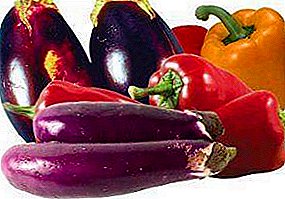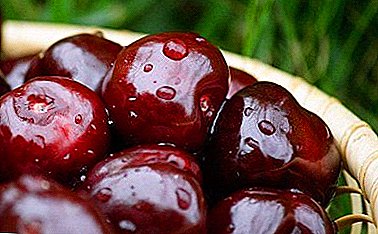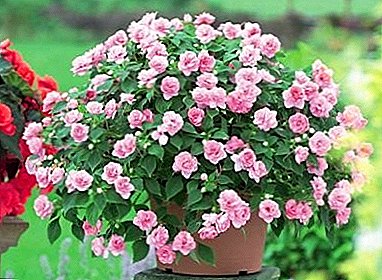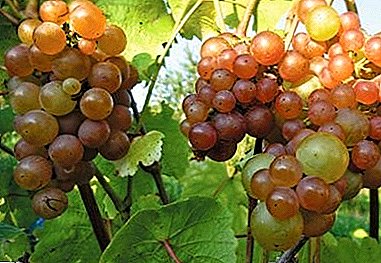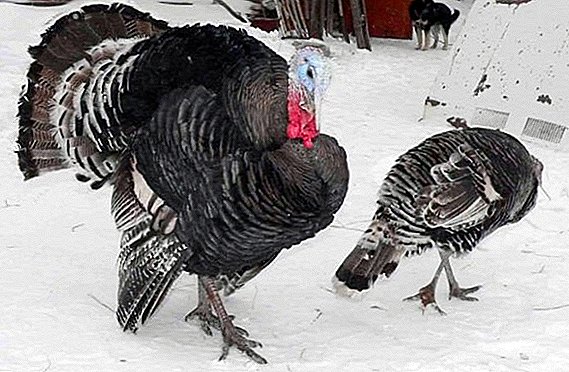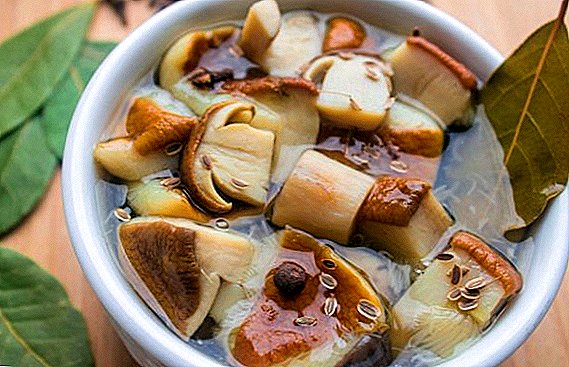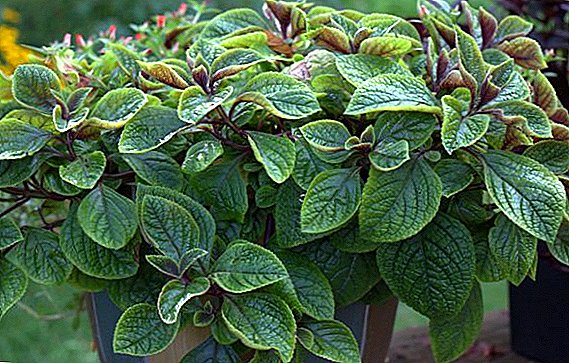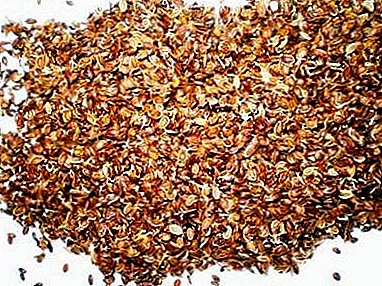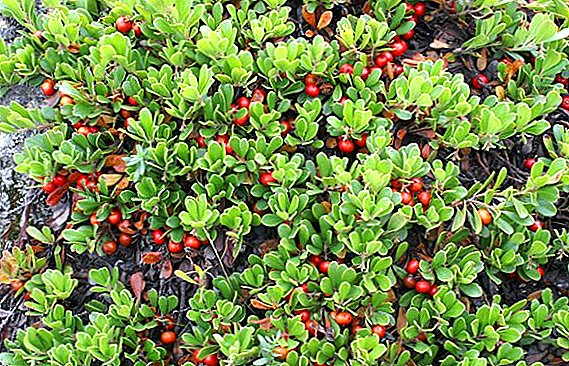 About shrub bearberry is not known to many. The plant does not belong to the advertised medical companies means, besides it grows in a rather harsh and remote regions of our planet. But despite this, the bush for more than one decade has been actively used in traditional medicine to combat many diseases. Often the medicinal properties of this species are open only to the select.
About shrub bearberry is not known to many. The plant does not belong to the advertised medical companies means, besides it grows in a rather harsh and remote regions of our planet. But despite this, the bush for more than one decade has been actively used in traditional medicine to combat many diseases. Often the medicinal properties of this species are open only to the select.
In this article we will try to reveal the secret of the plant of bearberry, and also to reveal how various extracts from this shrub can be useful for human health.
Description
Bearberry (bear ears) is a perennial evergreen shrub of the heather family, which belong to the dicotyledonous representatives of the modern flora. The plant is an aboriginal species of cold arctic and subarctic regions, therefore under natural conditions it grows widely in Siberia, the Caucasus, Central and North America, Central Europe. Outside the range shrub is quite rare, except for cultural conditions.
Did you know? The first mention of such a plant as bearberry is found in antiquity, in numerous works of ancient Greek and Roman scientists.Like most members of the family, bearberry grows predominantly on acidic forest soils or poor stony slopes, coastal dunes, burned areas and clearings. The plant prefers a well-clarified and ventilated area, far from complex plant cenoses, since it is rather difficult to tolerate competition. Bearberry is characterized by symbiosis with fungi, which manifests itself in mycorrhizal interactions between organisms in the root zone.
Depending on the climatic conditions, the height of the species may be in the range of 25-130 cm, the stem is creeping, branched. In most cases, the leaves are oblong, egg-shaped. Lamina slightly narrowed at the base in a characteristic petiole, well, and rounded at the top, mesh venation. The edge of the leaves whole, pubescence is not typical.
The location of the leaves on the surface of the shoots is next, their width is about 1 cm, the length is not more than 2 cm. The surface of the leaves is leathery, its upper part is predominantly shiny, dark green, the leaves are matte below, and their color is often pale green.  The blooming of bearberry begins in May and lasts until the end of June. At this time, the shoots are revealed light pink flowers with a five-prong aureole, which are collected in a kind of inflorescence-brush. After flowering on the plant ripen red spherical berries with a diameter of about 8 mm, in which there are 5 seeds.
The blooming of bearberry begins in May and lasts until the end of June. At this time, the shoots are revealed light pink flowers with a five-prong aureole, which are collected in a kind of inflorescence-brush. After flowering on the plant ripen red spherical berries with a diameter of about 8 mm, in which there are 5 seeds.
Did you know? In the 16th century, American colonists used the bear-ear plant to effectively treat jade.The use of shrubs in economic activities is quite wide. It can be a raw material for the preparation of medicines, dyes, as well as a source of tannins. Often bearberry is used as a treat for game bait, etc.
Chemical composition
The plant is rich in a huge number of various chemical compounds. It contains:
- Arbutin - up to 25%;
- tannins - up to 35%;
- gallic acid - about 6%;
- ash - 2.6%;
- ursolic acid - up to 0.8%;
- essential oil - 0.01%.

Arbutin, which gives bearberry antiseptic properties, is also found in blueberry leaves, Badane, pear, lingonberry leaves.In addition, in various parts of the plant revealed:
- methylarbutin;
- free hydroquinone;
- ellagic, quinic, formic acids;
- Ellagotanin;
- gallotanin;
- caud;
- hyperoside;
- quercetin;
- isoquercetin;
- ascorbic acid;
- wax;
- gum;
- mineral salts.

Flavonoid quercetin is a strong antioxidant, found in red onions, hawthorn, Voronetz, quince, ragweed, bulb onions, whiteweed, Kalanchoe, mountain ash red.Do not forget about the huge number of all kinds of trace elements (mg / kg):
- potassium - 5.70;
- calcium - 15.40;
- mangan - 2.20;
- iron - 0.07;
- magnesium - 18.00;
- copper - 8.64;
- zinc - 46.70;
- aluminum - 34.72;
- barium - 5.76;
- selenium - 0.10;
- nickel - 0.40;
- strontium - 8.32;
- lead - 0.80;
- boron - 3.14;
- iodine - 0.15.

Stocking
Often, in order to prepare medicines from bearberry, mainly leaves and shoots of the shrub are harvested. Traditionally, there are two periods of preparation of therapeutic raw materials: in the spring, before the onset of flowering, and in the fall, after the berries are fully ripe.
The leaves of the shoots are cut with a knife, scissors or a special secateur for shrubs. Leaves grow quite quickly, but they are no longer suitable for re-harvesting. Re-stocking the foliage of shrubs can be no earlier than 2 years.
The young parts of the plant are suitable for harvesting shoots, as they contain the largest number of various substances. Cut off young shoots with a knife or a special shears. The recovery rate of the stem of the shrub is much lower than the foliage, so the shoots are cut from the bush 1 time in 5 years. In most cases, for the extraction of raw materials shoots are cut along with the foliage, this speeds up the overall collection process.
Important! Pulling the bearberry bushes with roots is strictly prohibited, as this leads to the complete and irrevocable destruction of the undergrowth.
 Dry raw materials in attics, under sheds or in special rooms for drying. For this, parts of plants are laid out in 1 layer, as loosely as possible, and dried naturally.
Dry raw materials in attics, under sheds or in special rooms for drying. For this, parts of plants are laid out in 1 layer, as loosely as possible, and dried naturally.You can use and special units for drying, and the process should take place at a temperature in the range of + 60-90 ° C. After drying, it is necessary to separate the leaves from the stems and pack them in separate containers. The shelf life of such a collection is up to 5 years.
Bearberry Fees
Today bearberry is used to treat a variety of pathologies of organs and systems, therefore, in folk and traditional medicine for many decades, there are many recipes and recommendations for the use of this plant in therapeutic practice. Therefore, below we consider the most effective ones.
Most often, the plant is used as all sorts of herbal preparations for the treatment of pathologies of the genitourinary system. Such remedies safely and effectively treat many disorders of the organs, as well as help to eliminate their consequences. Here is an example of the most applicable fees:
Here is an example of the most applicable fees:
- inflammation of the kidneys and excretory tract eliminated thanks to a mixture of three-leaf watch leaves, bear ears, birch buds, blue cornflower flowers, elecampane root, and curly parsley fruits. The mixture is prepared in a ratio of 4: 2: 1: 1: 1: 1, respectively;
- oxalate kidney stones derived from the collection of flax seed, harrow root, bearberry leaves, madder root dye. The ratio of components 4: 2: 2: 1;
- with calculi in the kidneys, urinary bladder and ureters It will be possible to improve the condition of the body with the help of a mixture of 2 g of leaves of a Chernobyl herb, 3 g of bearberry leaves, 3 g of carrot seeds, 2 g of horsetail, 2 g of seeds of garden dill;
- pyelonephritis It is treated with a collection of equal parts of calendula flowers, birch leaves, heather grass, wintergreen leaves, clover grass, meadowsweet grass, shepherd's bag grass, tansy flowers;
- manifestations of prostatitis helps to remove the collection of herb fragrant, large plantain leaves, bearberry leaves, hung birch leaves. The ratio of components 4: 4: 4: 1;
- with cystitis used infusions of a mixture of leaves of bearberry and birch, licorice root and grass horsetail (each ingredient in 10 g). To this mixture add 20 g of flax seeds, lingonberry leaves and nettle grass;
- for diuretic effect You can use the collection of 10 g of yarrow, 10 g of bearberry leaves, 10 g of knotweed, 5 g of a three-fold sequence.

Did you know? As an effective tool to combat urolithiasis, bear ears have been used since the beginning of the 16th century.
All charges are brewed in the same way - 1 tsp. dry raw material is poured with a glass of boiling water, infused and filtered. Drink the amount received during the day, 3-5 times, in equal portions.
In addition, often herbal mixtures based on shrubs are used to eliminate other body disorders:
- for insomnia will save the infusion from a mixture of leaves of bear ears, birch leaves, licorice root and corn stigmas (the components are taken in equal parts);
- with neurosis a collection of equal parts of bearberry leaves and motherwort grass (2: 1) will help;
- remove puffiness will help the collection of equal parts of the leaves of bearberry, birch foliage and corn silk;
- relieve atherosclerosis a mixture of equal parts of bear ears, flowers of heart-shaped linden, oregano, peppermint leaves, large plantain, motherwort, horsetail, dried marshland, rosehips will help.

Medicinal properties
Bear ears have the following pharmacological properties:
- antiseptic;
- antimicrobial;
- antifungal;
- astringent;
- immunomodulatory;
- choleretic;
- diuretic;
- anti-inflammatory;
- diuretic.
It can not be combined in the collections of bearberry with yew, periwinkle, aconite, crocus, Corydalis, pokeweed, rue, stonecrop, Alokaziya, dope, lofant, kupenoy, Indian onions, bison, kanuperom, comfrey, dodder, soapwort, woodlice, anemones, elderberry, purslane , sage, stevia, herpes, goldenrod, veronica, cactus, euphorbia, physalis, zyuznik, rue, because they contain alkaloids.
Application
As mentioned above, the shrub is actively used as one of the components of various medicinal fees used in folk and traditional medicine.
However, this plant is effective and as the only active ingredient, preparations from which are capable of getting rid of all kinds of pathologies for a long time. Therefore, further we dive into this issue.
Important! The use of bearberry in combination with substances containing alkali and alkaloids is strictly prohibited, since such therapy can have a detrimental effect on the general condition of the body.Broth from parts of the bush help cope with gout. This tool is prepared as follows: in 0.5 l of water you need to boil for 15 minutes 3 tablespoons of dried leaves, then close the lid and insist to cool completely and strain.
Take the drug 2 times a day with meals 200 ml. This therapy is carried out until the complete disappearance of the symptoms of the disease.  The decoction is effective and as an immunomodulating drug. In this case, 5 tablespoons of the raw material is boiled in 1 liter of water for 10 minutes, and then insist under the lid for at least 2 hours, then filtered. Use this broth 50 ml 3-4 times a day, in small courses of 5-7 days.
The decoction is effective and as an immunomodulating drug. In this case, 5 tablespoons of the raw material is boiled in 1 liter of water for 10 minutes, and then insist under the lid for at least 2 hours, then filtered. Use this broth 50 ml 3-4 times a day, in small courses of 5-7 days.
In diseases of the gastrointestinal tract People enjoy tea from bear ears. To prepare it, 2 teaspoons of raw materials brewed in 200 ml of water. Use means 2 times a day in a warm kind by short courses.
With depression and increased emotional excitability This tea is made from 3 tablespoons of raw materials and 0.5 liters of water. Drink the infusion should be 0.1 l 2 times a day until complete improvement.
When depression is worth paying attention to turmeric, marigold, maral root, hyssop, colza, cilantro, peanuts, mordovnik, Chervil.
As a diuretic from bearberry prepare infusions. To do this, 2 teaspoons of raw materials insist in 0.2 liters of boiling water for 8-10 hours. Apply infusion of 75 ml (1/3 cup) 1 time per day. To increase the effect an hour after taking it is necessary to drink 1 cup of warm water.
In the fight against tuberculosis will help alcohol infusion of leaves of a bush. To prepare it, you need 2 tablespoons of dry raw material to insist in 0.1 l of vodka for 2 weeks. Apply the tool to 10-15 drops in a glass of water after a meal, 3 times a day. 
Did you know? At present, mankind knows about 320 thousand of all kinds of plants, but no more than 6% of them have a medicinal effect.Also, the plant has found its use in cosmetology. From the extracts of the shrub prepare quality tools to help cope with increased skin pigmentation. To do this, 2 tablespoons of leaves should be infused in 300 ml of boiling water until it cools completely, and then filtered thoroughly. The resulting liquid is poured into ice molds. Ice cubes should daily wipe the skin in the morning and evening.
This infusion can be used and hair rinse. In this case, the procedure can stop baldness, remove brittleness and other cosmetic problems.
Contraindications and harm
Despite the beneficial effects on the human body, like many other highly effective medicines, bearberry has a number of contraindications to use.
First of all, infusions, decoctions and other extracts of this shrub should be abandoned in case of acute kidney diseases, since such drugs can seriously irritate the tissues of the organs.  In addition, these tools should not be used during pregnancy, breastfeeding, under the age of 16, as well as in case of individual intolerance to the individual components of the plant.
In addition, these tools should not be used during pregnancy, breastfeeding, under the age of 16, as well as in case of individual intolerance to the individual components of the plant.
Important! When treating with bearberry-based products, the dosage should be carefully observed and long courses of treatment should be avoided, as this may adversely affect the general condition of the body.The main side effects of the use of drugs based on extracts of this shrub are: vomiting, diarrhea, nausea and other symptoms of poisoning, allergies, premature birth or miscarriage (during pregnancy).
How to choose when buying in the market
It is not a difficult task to acquire a quality collection or pure raw material from bear ears. In most cases, the components of this plant sold in pharmacies or specialized stores meet all modern qualities and medical standards.  However, with acquired bearberry, the situation is not so rosy. Many unscrupulous herbalists trade in low-quality raw materials or outright frank falsification, so you should always be careful with products purchased on the market.
However, with acquired bearberry, the situation is not so rosy. Many unscrupulous herbalists trade in low-quality raw materials or outright frank falsification, so you should always be careful with products purchased on the market.
In the network there are many ways to check the quality of raw materials, but the most effective is based on the active chemical reaction of shrub extracts with iron sulfate. To check the quality and authenticity of bearberry, you should prepare a water extract from raw materials in the ratio of 50: 1. After cooling and straining into liquid, it is necessary to dip 1 crystal of ferrous sulfate. In the case of a quality product, the substance will change its color to red, then blue, and at the end of the reaction a precipitate of a dark purple hue will appear.
Important! When treating with bearberry preparations, it is necessary to completely eliminate or limit the use of products containing animal protein.
 Bearberry is a fairly powerful and safe product that makes it possible to cope with many ailments, as well as to alleviate their consequences. This is one of the few plants that can have a really noticeable effect on the body in a short period of application, without having any serious side effects. However, it is necessary to use the extracts from this plant with caution, as overdose with its highly active components threatens serious intoxication of the body.
Bearberry is a fairly powerful and safe product that makes it possible to cope with many ailments, as well as to alleviate their consequences. This is one of the few plants that can have a really noticeable effect on the body in a short period of application, without having any serious side effects. However, it is necessary to use the extracts from this plant with caution, as overdose with its highly active components threatens serious intoxication of the body.

